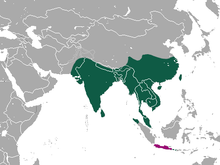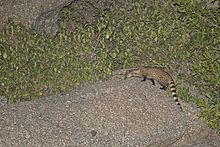Small Indian civet
| Small Indian civet | |
|---|---|
 | |
| In Silchar, Assam, India | |
Conservation status | |
 Least Concern (IUCN 3.1)[1] | |
Scientific classification | |
| Kingdom: | Animalia |
| Phylum: | Chordata |
| Class: | Mammalia |
| Order: | Carnivora |
| Family: | Viverridae |
| Subfamily: | Viverrinae |
| Genus: | Viverricula Hodgson, 1838 |
| Species: | V. indica |
Binomial name | |
Viverricula indica[2] Geoffroy Saint-Hilaire, 1803 | |
| Subspecies | |
List
| |
 | |
| Small Indian civet range (green - extant, pink - probably extant) | |

The small Indian civet is a nocturnal hunter.
The small Indian civet (Viverricula indica) is a civet native to South and Southeast Asia. It is listed as Least Concern on the IUCN Red List because of its widespread distribution, widespread habitat use and healthy populations living in agricultural and secondary landscapes of many range states.[1]
The small Indian civet is a monotypic genus.[3]
Contents
1 Taxonomy and evolution
1.1 Subspecies
2 Characteristics
3 Distribution and habitat
4 Ecology and behavior
4.1 Diet
4.2 Reproduction
5 Threats
6 Conservation
7 References
8 External links
Taxonomy and evolution
The genus Viverricula was named by the English naturalist Brian Houghton Hodgson in 1838 with the small Indian civet as the sole member.[2]Viverricula rasse described by Horsfield from Java is considered a variety of Viverricula indica.[4]
A phylogenetic study showed that the small Indian civet is closely related to the genera Civettictis and Viverra. It was estimated that the Civettictis-Viverra clade diverged from Viverricula around 16.2 Mya. The authors suggested that the subfamily Viverrinae should be bifurcated into Genettinae including Poiana and Genetta, and Viverrinae including Civettictis, Viverra and Viverricula. The following cladogram is based on this study.[5]
.mw-parser-output table.clade{border-spacing:0;margin:0;font-size:100%;line-height:100%;border-collapse:separate;width:auto}.mw-parser-output table.clade table.clade{width:100%}.mw-parser-output table.clade td{border:0;padding:0;vertical-align:middle;text-align:center}.mw-parser-output table.clade td.clade-label{width:0.8em;border:0;padding:0 0.2em;vertical-align:bottom;text-align:center}.mw-parser-output table.clade td.clade-slabel{border:0;padding:0 0.2em;vertical-align:top;text-align:center}.mw-parser-output table.clade td.clade-bar{vertical-align:middle;text-align:left;padding:0 0.5em}.mw-parser-output table.clade td.clade-leaf{border:0;padding:0;text-align:left;vertical-align:middle}.mw-parser-output table.clade td.clade-leafR{border:0;padding:0;text-align:right}
| |
| |||||||||||||||||||||||||||||||||
| |
Subspecies
The following nine subspecies are identified:[2][6]
V. i. indica (Geoffroy Saint-Hilaire, 1803) — is distributed in Southern India from the Western to the Eastern Ghats and as far north as Lake Chilka on the east coast;[7]
V. i. pallida (Gray, 1831) — ranges in southern China and Taiwan;[8]
V. i. bengalensis (Gray and Hardwicke, 1832) — lives in the plains of Northern India, south of the Ganges, from Calcutta to Gujarat, and possibly Sind;[7]
V. i. deserti (Bonhote, 1898) — was described from Rajputana;[7]
V. i. thai (Kloss, 1919) — is distributed in Thailand, Indochina, and Myanmar;[7]
V. i. muriavensis (Sody, 1931) — was described from Java and Bali;[9]
V. i. mayori (Pocock, 1933) — is distributed in Sri Lanka;[7]
V. i. wellsi (Pocock, 1933) — is distributed in Kangra, Kumaun, and the United Provinces;[7]
V. i. baptistæ (Pocock, 1933) — ranges from Bhutan and Upper Bengal to Assam.[7]
Characteristics
The small Indian civet is 21 to 23 in (53 to 58 cm) in head and body size and has a rather coarse fur that is brownish grey to pale yellowish brown, with usually several longitudinal black or brown bands on the back and longitudinal rows of spots on the sides. In some specimens both lines and spots are indistinct, and the dorsal bands are occasionally wanting. Usually there are five or six distinct bands on the back and four or five rows of spots on each side. The neck markings are rather variable. Generally there are two dark stripes from behind the ear to the shoulders, and often a third in front, crossing the throat. The underfur is brown or grey, often grey on the upper parts of the body and brown on the lower. The grey hairs on the upper parts are often tipped with black. The head is grey or brownish grey, the chin often brown. The ears are short and rounded with a dusky mark behind each ear, and one in front of each eye. The feet are brown or black. The tapering tail is 15 to 17 in (38 to 43 cm) long with alternating black and whitish rings, seven to nine of each colour.[3]
Distribution and habitat
Small Indian civets are known to occur in south and central China, Hong Kong, most of India, Lao PDR, Myanmar, Thailand, Viet Nam, Cambodia and Sri Lanka. No search has been made for recent records from Nepal, Bhutan, Bangladesh, Peninsular Malaysia, Java or Bali, areas where they were historically recorded. Their current status in Singapore is unclear.[1] They have been introduced to Madagascar.[10]
Small Indian civets have been recorded in semi-evergreen and deciduous forest, mixed deciduous forest, bamboo forest, scrubby areas, grasslands and riverine habitat.[11][12][13]
Ecology and behavior
Small Indian civets are nocturnal, mostly terrestrial and insectivorous.[12] They inhabit holes in the ground, under rocks or in thick bush.[3]
Diet
They feed on rats, mice, birds, snakes, fruit, roots and carrion.[10] Occasionally they carry off poultry.[3][13]
Reproduction
The female has usually four or five young at a birth.[3] The life span is eight to nine years.[10]
Threats
People of Traspur village in Assam hunt it for meat and purify its skin into medicine.[citation needed]
Conservation
Viverricula indica is listed on CITES Appendix III.[1] In Myanmar, it is totally protected under the Wildlife Act of 1994.[13]
References
^ abcd Choudhury, A.; Duckworth, J.W.; Timmins, R.; Chutipong, W.; Willcox, D.H.A.; Rahman, H.; Ghimirey, Y. & Mudappa, D. (2015). "Viverricula indica". The IUCN Red List of Threatened Species. IUCN. 2015: e.T41710A45220632. doi:10.2305/IUCN.UK.2015-4.RLTS.T41710A45220632.en. Retrieved 29 October 2018..mw-parser-output cite.citation{font-style:inherit}.mw-parser-output q{quotes:"""""""'""'"}.mw-parser-output code.cs1-code{color:inherit;background:inherit;border:inherit;padding:inherit}.mw-parser-output .cs1-lock-free a{background:url("//upload.wikimedia.org/wikipedia/commons/thumb/6/65/Lock-green.svg/9px-Lock-green.svg.png")no-repeat;background-position:right .1em center}.mw-parser-output .cs1-lock-limited a,.mw-parser-output .cs1-lock-registration a{background:url("//upload.wikimedia.org/wikipedia/commons/thumb/d/d6/Lock-gray-alt-2.svg/9px-Lock-gray-alt-2.svg.png")no-repeat;background-position:right .1em center}.mw-parser-output .cs1-lock-subscription a{background:url("//upload.wikimedia.org/wikipedia/commons/thumb/a/aa/Lock-red-alt-2.svg/9px-Lock-red-alt-2.svg.png")no-repeat;background-position:right .1em center}.mw-parser-output .cs1-subscription,.mw-parser-output .cs1-registration{color:#555}.mw-parser-output .cs1-subscription span,.mw-parser-output .cs1-registration span{border-bottom:1px dotted;cursor:help}.mw-parser-output .cs1-hidden-error{display:none;font-size:100%}.mw-parser-output .cs1-visible-error{font-size:100%}.mw-parser-output .cs1-subscription,.mw-parser-output .cs1-registration,.mw-parser-output .cs1-format{font-size:95%}.mw-parser-output .cs1-kern-left,.mw-parser-output .cs1-kern-wl-left{padding-left:0.2em}.mw-parser-output .cs1-kern-right,.mw-parser-output .cs1-kern-wl-right{padding-right:0.2em}
^ abc Wilson, D.E.; Reeder, D.M., eds. (2005). Mammal Species of the World: A Taxonomic and Geographic Reference (3rd ed.). Johns Hopkins University Press. p. 559. ISBN 978-0-8018-8221-0. OCLC 62265494.
^ abcde Blanford, W. T. (1888–91). Genus Viverricula Hodgson. Pages 100–101 in: The fauna of British India, including Ceylon and Burma. Mammalia. Taylor and Francis, London.
^ Horsfield, T. (1851). A catalogue of the Mammalia in the Museum of the Hon. East-India Company. J. & H. Cox, London.
^ Gaubert, P.; Cordeiro-Estrela, P. (2006). "Phylogenetic systematics and tempo of evolution of the Viverrinae (Mammalia, Carnivora, Viverridae) within feliformians: implications for faunal exchanges between Asia and Africa" (PDF). Molecular Phylogenetics and Evolution. 41 (2): 266–278. doi:10.1016/j.ympev.2006.05.034. PMID 16837215.

^ "Viverricula indica". Integrated Taxonomic Information System. Retrieved 19 April 2016.
^ abcdefg Pocock, R. I. (1939). Genus Viverricula Hodgson. Pages 362–376 in: The fauna of British India, including Ceylon and Burma. Mammalia. – Volume 1Taylor and Francis, London.
^ Ellerman, J. R., Morrison-Scott, T. C. S. (1966). Checklist of Palaearctic and Indian mammals 1758 to 1946. Second edition. British Museum of Natural History, London. Pp. 282–283.
^ Sody, H. J. V. (1931). Six new mammals from Sumatra, Java, Bali and Borneo. Natuurkundig Tijdschrift voor Nederlandsch-Indië 91: 349–360.
^ abc Lekalul, B. and McNeely, J. A. (1977). Mammals of Thailand. Association for the Conservation of Wildlife, Bangkok.
^ Duckworth, J. W. (1997). Small carnivores in Laos: a status review with notes on ecology, behaviour and conservation. Small Carnivore Conservation 16: 1–21.
^ ab Mudappa, D. (2002). Observations of small carnivores in the Kalakad-Mundanthurai Tiger Reserve, Western Ghats, India. Small Carnivore Conservation 27 Archived 2011-07-28 at the Wayback Machine.: 4–5.
^ abc Su Su. (2005). Small carnivores and their threats in Hlawga Wildlife Park, Myanmar. Small Carnivore Conservation 33 Archived 2015-01-29 at the Wayback Machine.: 6–13.
External links
Wikispecies has information related to Viverricula indica |
| Wikimedia Commons has media related to Viverricula indica. |
Raising Small Indian civet (Viverricula indica) website www.vietlinh.vn- Fact file from Pensacola Junior College